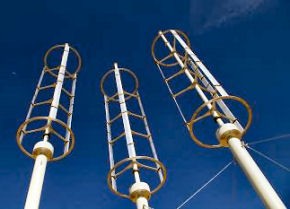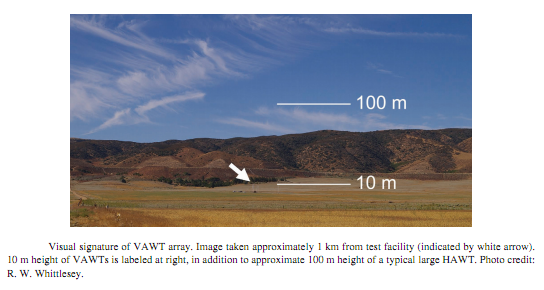Removing the ugliness of wind power. The photo opportunity of Julia Gillard at a Crookwell wind farm did not go exactly as intended. Sure the pictures of an alternative to carbon spewing power stations were there but so were the opponents of these giant wind turbines. Environmentally sound they may be but the turbines are an aesthetic nightmare and a noisy nuisance to many living close to them.
The federal government’s $10 billion investment in the greater use of renewable energy is not a sure fire vote winner when it subsidises rural ugliness. The president of the NSW Landscape Guardians, Humphrey Price-Jones, who the Sydney Morning Herald reports, lives near Crookwell and the site of a planned wind turbine, has lobbied the government to suspend all development applications for wind farms until any noise-related health risks are assessed. It was views like his that took some of the gloss off Ms Gillard’s visit.
Perhaps a solution for the Prime Minister would be to divert some of renewable energy dollars into supporting an apparently promising wind power alternative under development at Caltech University in the United States. There the boffins are working away on a new form of wind turbine that’s nowhere near as destructive as the present monsters.
Looking something like egg beaters these turbines stand only 10 metres high and a placed much closer together than those on the spread out wind farms of today.

A report in the currently online version of the Journal of Renewable and Sustainable Energy titled “Potential order-of-magnitude enhancement of wind farm power density via counter-rotating vertical-axis wind turbine arrays” is introduced in this way:
“A principal challenge for all forms of renewable energy is that their sources — solar radiation or wind, for example — are more diffuse than fossil fuels. As a consequence, existing renewable energy technologies require substantial land resources in order to extract appreciable quantities of energy. This limitation of land use is especially acute in the case of wind energy, which currently faces an additional constraint in that conventional propeller-style wind turbines (i.e., horizontal-axis wind turbines; henceforth, HAWTs) must be spaced far apart in order to avoid aerodynamic interference caused by interactions with the wakes of adjacent turbines.
“This requirement has forced wind energy systems away from high energy demand population centers and toward remote locations including, more recently, offshore sites. It has also necessitated the implementation of very large wind turbines, so that the inefficiency of the wind farm as a whole can be compensated by accessing the greater wind resources available at high altitudes. However, this solution comes at the expense of higher engineering costs and greater visual, acoustic, radar, and environmental impacts. These issues represent a principal barrier to the realization of wind energy technology that is both economically viable and socially acceptable.
“To maintain 90% of the performance of isolated HAWTs, the turbines in a HAWT farm must be spaced 3–5 turbine diameters apart in the cross-wind direction and 6–10 diameters apart in the downwind direction.1,2 The power density of such wind farms, defined as the power extracted per unit land area, is between 2 and 3 W m−2
“Wind turbines whose airfoil blades rotate around a vertical axis (i.e., vertical-axis wind turbines; henceforth, VAWTs) have the potential to achieve higher power densities than HAWTs. This possibility arises in part because the swept area of a VAWT rotor (i.e., the cross-sectional area that interacts with the wind) need not be equally apportioned between its breadth — which determines the size of its footprint — and its height.
“By contrast, the circular sweep of HAWT blades dictates that the breadth and height of the rotor swept area are identical. Therefore, whereas increasing HAWT rotor swept area necessarily increases the turbine footprint, it is possible to increase the swept area of a VAWT independent of its footprint, by increasing the rotor blade height. … The power density of the VAWT design is more than three times that of the HAWTs, suggesting that VAWTs may be a more effective starting point than HAWTs for the design of wind farms with high power density.
“The turbine power densities indicated … are not achieved in practice due to the aforementioned spacing requirements between the turbines in a wind farm. However, we hypothesized that counter-rotating arrangements of VAWTs can benefit from constructive aerodynamic interactions between adjacent turbines, thereby mitigating reductions in the performance of the turbines when in close proximity. By accommodating a larger number of VAWTs within a given wind farm footprint, the power density of the wind farm is increased.
“Furthermore, by capturing a greater proportion of the wind energy incident on the wind farm footprint, it becomes unnecessary to use wind turbines as large as those commonly found in modern HAWT farms. In turn, the use of smaller turbines can reduce the complexity and cost of the individual wind turbines, since the smaller wind turbines do not experience the high gravitational, centrifugal, and wind loading that must be withstood by large HAWTs. The less severe design requirements can enable the implementation of less expensive materials and manufacturing processes.”
There’s a long way to go from this initial small scale testing to a proven new style wind farm but the picture below shows one benefit there would be from success:

A question time with questions. We had better stop referring to the House of Representatives as being a Westminster system of government. Anyone who listened to last night’s House of Commons Prime Minister’s question time on the Murdoch scandals would realise just how far Australia’s parliamentary system has degenerated.
In the UK people not only asked proper questions but a Prime Minister actually answered them without waffle. Watching a replay of the proceedings should be made compulsory for all our MPs in the hope that they learn that question time does not have to be a meaningless waste of time.
The mystery consultants. Given the frankness of so many of his answers I was intrigued that the British Prime Minister David Cameron repeatedly refused to reveal which company had given him a report on Andy Coulson’s suitability for employment as his press adviser. Mr Cameron just kept batting back the inquiries with the reply that he took the responsibility himself. Strange indeed.
Almost as strange as who it was at News International who thought it was a good idea to keep paying the legal fees of Glenn Mulcaire. That question, I expect, is one that will soon be answered.
Backing Rupert to remain the boss. I’ve done alright over the years backing dictators to stay in power when many think they are on the way out. That Mugabe man has done wonders for the punting purse!
Currently I have a few dollars on Libya’s Gaddafi to still be around at the end of the year and Syria’s Bashar al-Assad only has to last until the end of the month to give me a nice little earn.
So when it comes to whether Rupert Murdoch will still be CEO of News Corporation come 31 December I am tempted to lay the odds at Intrade that say he is an 84% chance of doing so.
The old fellow might have looked tired and harassed the other night appearing before that House of Commons committee but I doubt he would risk getting a right hook himself by tossing away the perks of office.







Point of clarity, is it true Cameron picked up Coulson at a “Rent a Mole” clearance sale? Or was it, as a friend told me, “Moles R Us”?
Aesthetic nightmare? Seen a transmission line lately, or a highway? Now they are nightmares.
And noise? I live 1 kilometer away from the Gateway at Deagon, with a forest (soon to be ripped apart to extend the road) in between us. That is noise!
“Winds of change fail to sweep up Gillard”
There simply is NO NEED for a PM to visit wind farms or just for the sake of photo opportunities to be seen madly running around the countryside “kissing babies”. As PM it is important to regularly REPORT to the public as succinctly as possible what the government has done, what it is currently doing and what it is planning for the future. It is YOUR JOB to make OZ a better place. Get on with it!
I second MICHAEL CROOK at 4:04 pm; and Richard Farmer is at risk of being lumped in the old curmudgeon fossil category (like our grumpy blogger Frank Campbell who has chronic nimbyitis and will be along here soon I am sure). The latest guff about so-called infrasound and health risks is utterly without scientific or medical evidence and it will be a travesty if it holds up building of wind farms.
Still, good find. VAWT have been around for ages (they are the type fitted to buildings etc.) but the trick here of closer spacing with counter-rotating pairs is just one of those ridiculously simple things. It shows that serious research funds always produce a return and often come up with something unexpected.
Still it is a long way to match the >20MW HAWT in-development by Vesta. Designed for marine environs with strong consistent winds, you only need 50 of them and you have a GigaWatt, roughly equivalent to one fossil fueled generator.
The scourge of infrasound has been found to have a simple cure – MONEY.
As to uglification, try selling a house near Wallerawang in NSW, or adjacent to any other coal fired satanic mill.
As MickRJ points out, VAWT have been around for a while, millennia if one acknowledges Cretan windmills for grinding grain.
The main reason the current giant verticals were (over) developed was for the N European market with those bastard North Sea winds.
Gentle zephyrs didn’t get a look in.